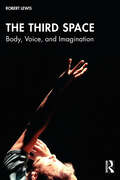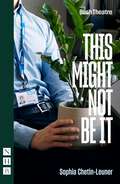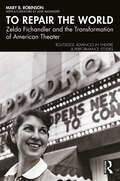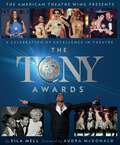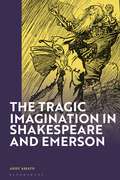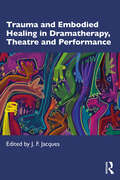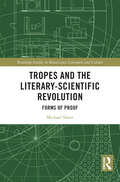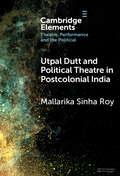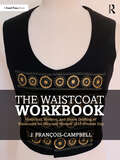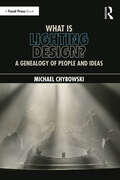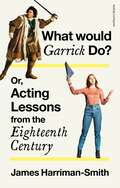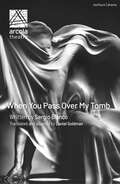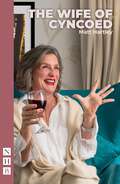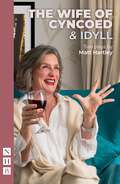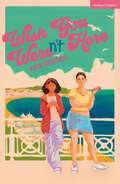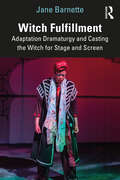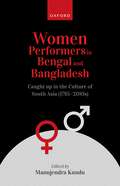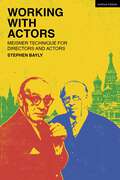- Table View
- List View
The Third Space: Body, Voice, and Imagination
by Robert LewisThe Third Space serves a crucial need for contemporary performers by providing an interdisciplinary and physiovocal approach to training. It is a new take on body and voice integration designed to develop the holistic performer. It takes performers through a series of step-by-step practical physiovocal exercises that connects the actor’s centre to the outside world, which increases awareness of self and space. It also develops a deeper connection between spaces within the body and the environment by connecting sound, imagination, and movement.Robert Lewis’s approach is a way of working that unlocks the imagination as well as connecting performers to self, space, and imagination, through voice and body. It conditions, controls, and engages performers by integrating various voice and movement practices.The theories and practice are balanced throughout by: introducing the practical works theoretical underpinnings through research, related work, and case studies of performances; demonstrating a full program of exercises that helps performers get in touch with their centre, their space, and shape both within and outside the body; and exploring the performers physiovocal instrument and its connection with imagination, energies, and dynamics. This book is the result of nearly 20 years of research and practice working with voice and movement practitioners across the globe to develop training that produces performers that are physiovocally ready to work in theatre, screen, and emergent technologies.
The Third Space: Body, Voice, and Imagination
by Robert LewisThe Third Space serves a crucial need for contemporary performers by providing an interdisciplinary and physiovocal approach to training. It is a new take on body and voice integration designed to develop the holistic performer. It takes performers through a series of step-by-step practical physiovocal exercises that connects the actor’s centre to the outside world, which increases awareness of self and space. It also develops a deeper connection between spaces within the body and the environment by connecting sound, imagination, and movement.Robert Lewis’s approach is a way of working that unlocks the imagination as well as connecting performers to self, space, and imagination, through voice and body. It conditions, controls, and engages performers by integrating various voice and movement practices.The theories and practice are balanced throughout by: introducing the practical works theoretical underpinnings through research, related work, and case studies of performances; demonstrating a full program of exercises that helps performers get in touch with their centre, their space, and shape both within and outside the body; and exploring the performers physiovocal instrument and its connection with imagination, energies, and dynamics. This book is the result of nearly 20 years of research and practice working with voice and movement practitioners across the globe to develop training that produces performers that are physiovocally ready to work in theatre, screen, and emergent technologies.
This Might Not Be It (Nhb Modern Plays Ser.)
by Sophia Chetin-LeunerJay's new. He's just started as a temp in NHS Child and Adolescent Mental Health Services. He arrives with little more than a fledgling desk plant and well-meaning plans to change the broken system. Angela's been working here for over thirty years and nothing seems to faze her – except Jay. Exhausted and worn down by archaic protocol, Jay starts bending the rules in a desperate attempt to help their patients. But when professional boundaries are crossed and trust is shattered, he discovers the harsh reality of what's truly at stake. Sophia Chetin-Leuner's play This Might Not Be It is a candid portrayal of human lives at the mercy of our crumbling NHS. The play was longlisted for the Verity Bargate Award and shortlisted for the Women's Prize for Playwriting. It was premiered at the Bush Theatre, London, in 2023, directed by Ed Madden and produced by Broccoli Arts and Jessie Anand Productions. 'The beauty of this piece is that it speaks in a universal language about the way people find ways of co-existing in an office where space is tight and time is short' - The Times 'Intriguing and immensely engaging' - Guardian 'Timely and compelling& the characters are startlingly vivid, filled with hopes, flaws and intriguing contradictions' - The Stage 'Affecting, with much to admire' - Telegraph
To Repair the World: Zelda Fichandler and the Transformation of American Theater (ISSN)
by Mary B. RobinsonThis book is a biography in the form of an oral history about a woman whose founding of Arena Stage in Washington, DC in 1950 shifted live professional theater away from Broadway and inspired the creation of non-profit theaters around the country. Dianne Wiest, James Earl Jones, Stacy Keach, and Jane Alexander, among many others, share their memories of this intrepid pioneering woman during Arena Stage’s early years.As Head of New York University’s Graduate Acting Program for 25 years, Zelda Fichandler also trained a younger generation of gifted actors. Marcia Gay Harden, Rainn Wilson, Mahershala Ali, and other developing actors who became “artist-citizens” under her guidance, talk about the ways in which she transformed their lives.Theater practitioners who have lived during Zelda Fichandler’s time will find this book a fascinating and entertaining read––as will all theater lovers, especially those in Washington, DC. And through this vivid and compelling oral history, students and aspiring artists will come to grasp how the theatrical past can shed essential light on the theater of today and tomorrow.
To Repair the World: Zelda Fichandler and the Transformation of American Theater (ISSN)
by Mary B. RobinsonThis book is a biography in the form of an oral history about a woman whose founding of Arena Stage in Washington, DC in 1950 shifted live professional theater away from Broadway and inspired the creation of non-profit theaters around the country. Dianne Wiest, James Earl Jones, Stacy Keach, and Jane Alexander, among many others, share their memories of this intrepid pioneering woman during Arena Stage’s early years.As Head of New York University’s Graduate Acting Program for 25 years, Zelda Fichandler also trained a younger generation of gifted actors. Marcia Gay Harden, Rainn Wilson, Mahershala Ali, and other developing actors who became “artist-citizens” under her guidance, talk about the ways in which she transformed their lives.Theater practitioners who have lived during Zelda Fichandler’s time will find this book a fascinating and entertaining read––as will all theater lovers, especially those in Washington, DC. And through this vivid and compelling oral history, students and aspiring artists will come to grasp how the theatrical past can shed essential light on the theater of today and tomorrow.
The Tony Awards: A Celebration of Excellence in Theatre
by Eila Mell The American Theatre WingCommemorating over 75 years of Broadway greatness with never-before told stories, rare photos from the American Theatre Wings' archives, and interviews with major honorees like Lin-Manuel Miranda, Patti LuPone, and Hugh Jackman, The Tony Awards is the official, authorized guide to Broadway's biggest night.The Tony Awards: A Celebration of Excellence in Theatre pays tribute to the magic that happens when the curtain goes up and Broadway's best and brightest step onto center stage. Supported by the American Theatre Wing, the arts organization that founded the Tony Awards in 1947 and continues to produce the Tony Awards live telecast each year, author Eila Mell has interviewed a cavalcade of past and present Tony winners, including actors, producers, writers, costume designers, and many many others. Their voices fill the pages of this book with fascinating, behind-the-scenes stories about what it's like to win the theatre world's highest honor. Featuring a foreword by Audra McDonald and over 400 color and black-and-white photographs, The Tony Awards also spotlights more than 130 captivating interviews with a parade of industry insiders, including: Mel Brooks, Matthew Broderick, Carol Burnett, Kristin Chenoweth, Glenn Close, James Corden, Bryan Cranston, Neil Patrick Harris, Jennifer Holliday, Hugh Jackman, John Kander, Angela Lansbury, Judith Light, Hal Linden, Kenny Leon, Patti LuPone, Lin-Manuel Miranda, Brian Stokes Mitchell, Rita Moreno, Bernadette Peters, Chita Rivera, Martin Short, Tom Stoppard, Julie Taymor, Leslie Uggams, and Sir Andrew Lloyd Webber.
The Tragic Imagination in Shakespeare and Emerson
by Andy AmatoWhat is the “tragic imagination”? And what role does it play in the works of William Shakespeare and Ralph Waldo Emerson? Explaining the tragic imagination as a creative faculty employed to answer the perennial Riddle of the Sphinx – a theory of the world that advances human freedom and dignity in the face of historical injustice, cruelty and violence – Andy Amato seeks to recover and rehabilitate this concept by revealing its significance to both key works of philosophy and literature and our contemporary world. This book begins with a close and careful reading of Emerson's first major work, Nature, in conversation with nineteenth and 20thcentury continental philosophy, critical theory and post-structuralism. Uncovering neglected elements of Emerson's philosophy, beyond his reputation as the philosopher of 'cheer', this book explores how Emersonian transcendentalism affirms rather than denies the tragic sense of life – “tragic idealism” – and makes a substantial contribution to philosophy's perpetual endeavour to solve the Riddle. In the second part of the book, Amato then employs Emerson's theoretical lens to interpret Shakespeare's tragedy, King Lear. In doing so, he innovatively reframes the central themes of suffering, vision, nature, nothing, foolishness and silence toward achieving liberation.By pairing these two giants of literature and philosophy, The Tragic Imagination in Shakespeare and Emerson not only offers fresh interpretations of Nature and King Lear, but also makes the case for the renewed deployment of tragic imagination, in creative redress, to our current social-political situation.
Trauma and Embodied Healing in Dramatherapy, Theatre and Performance
by J. F. JacquesThis edited volume explores the singularity of embodiment and somatic approaches in the healing of trauma from a dramatherapy, theatre and performance perspective.Collating voices from across the fields of dramatherapy, theatre and performance, this book examines how different interdisciplinary and intercultural approaches offer unique and unexplored perspectives on the body as a medium for the exploration, expression and resolution of chronic, acute and complex trauma as well as collective and intergenerational trauma. The diverse chapters highlight how the intersection between dramatherapy and body-based approaches in theatre and performance offers additional opportunities to explore and understand the creative, expressive and imaginative capacity of the body, and its application to the healing of trauma.The book will be of particular interest to dramatherapists and other creative and expressive arts therapists. It will also appeal to counsellors, psychotherapists, psychologists and theatre scholars.
Trauma and Embodied Healing in Dramatherapy, Theatre and Performance
This edited volume explores the singularity of embodiment and somatic approaches in the healing of trauma from a dramatherapy, theatre and performance perspective.Collating voices from across the fields of dramatherapy, theatre and performance, this book examines how different interdisciplinary and intercultural approaches offer unique and unexplored perspectives on the body as a medium for the exploration, expression and resolution of chronic, acute and complex trauma as well as collective and intergenerational trauma. The diverse chapters highlight how the intersection between dramatherapy and body-based approaches in theatre and performance offers additional opportunities to explore and understand the creative, expressive and imaginative capacity of the body, and its application to the healing of trauma.The book will be of particular interest to dramatherapists and other creative and expressive arts therapists. It will also appeal to counsellors, psychotherapists, psychologists and theatre scholars.
Tropes and the Literary-Scientific Revolution: Forms of Proof (Routledge Studies in Renaissance Literature and Culture)
by Michael SlaterTropes and the Literary-Scientific Revolution: Forms of Proof argues that the rise of mechanical science in the seventeenth century had a profound impact on both language and literature. To the extent that new ideas about things were accompanied by new attitudes toward words, what we commonly regard as the “scientific revolution” inevitably bore literary dimensions as well. Literary tropes and forms underwent tremendous reassessment in the seventeenth century, and early modern science was shaped just as powerfully by contest over the place of literary figures, from personification and metaphor to anamorphosis and allegory. In their rejection of teleological explanations of natural motion, for instance, early modern philosophers often disputed the value of personification, a figural projection of interiority onto what was becoming increasingly a mechanical world. And allegory—a dominant mode of literature from the late Middle Ages until well into the Renaissance—became “the vice of those times,” as Thomas Rymer described it in 1674. This book shows that its acute devaluation was possible only in conjunction with a distinctively modern physics. Analyzing writings by Sidney, Shakespeare, Bacon, Jonson, Brahe, Kepler, Galileo, Hobbes, Descartes, and more, it asserts that the scientific revolution was a literary phenomenon, just as the literary revolution was also a scientific one.
Tropes and the Literary-Scientific Revolution: Forms of Proof (Routledge Studies in Renaissance Literature and Culture)
by Michael SlaterTropes and the Literary-Scientific Revolution: Forms of Proof argues that the rise of mechanical science in the seventeenth century had a profound impact on both language and literature. To the extent that new ideas about things were accompanied by new attitudes toward words, what we commonly regard as the “scientific revolution” inevitably bore literary dimensions as well. Literary tropes and forms underwent tremendous reassessment in the seventeenth century, and early modern science was shaped just as powerfully by contest over the place of literary figures, from personification and metaphor to anamorphosis and allegory. In their rejection of teleological explanations of natural motion, for instance, early modern philosophers often disputed the value of personification, a figural projection of interiority onto what was becoming increasingly a mechanical world. And allegory—a dominant mode of literature from the late Middle Ages until well into the Renaissance—became “the vice of those times,” as Thomas Rymer described it in 1674. This book shows that its acute devaluation was possible only in conjunction with a distinctively modern physics. Analyzing writings by Sidney, Shakespeare, Bacon, Jonson, Brahe, Kepler, Galileo, Hobbes, Descartes, and more, it asserts that the scientific revolution was a literary phenomenon, just as the literary revolution was also a scientific one.
Utpal Dutt and Political Theatre in Postcolonial India (Elements in Theatre, Performance and the Political)
by null Mallarika Sinha RoyAmong the most significant playwrights and theatre-makers of postcolonial India, Utpal Dutt (1929–1993), was an early exponent of rethinking colonial history through political theatre. Dutt envisaged political theatre as part of the larger Marxist project, and his incorporation of new developments in Marxist thinking, including the contributions of Antonio Gramsci, makes it possible to conceptualise his protagonists as insurgent subalterns. A decolonial approach to staging history remained a significant element in Dutt's artistic project. This Element examines Dutt's passionate engagement with Marxism and explores how this sense of urgency was actioned through the writing and producing of plays about the peasant revolts and armed anti-colonial movements which took place during the period of British rule. Drawing on contemporary debates in political theatre regarding the autonomy of the spectator and the performance of history, the author locates Dutt's political theatre in a historical frame.
The Waistcoat Workbook: Historical, Modern and Genre Drafting of Waistcoats for Men and Women 1837 – Present Day
by J. François-CampbellThe Waistcoat Workbook: Historical, Modern, and Genre Drafting of Waistcoats for Men and Women 1837–Present Day provides comprehensive coverage of the design, construction, and role of waistcoats from the reign of Queen Victoria to the present day in the United Kingdom.The book contains step-by-step instructions on how to draft the garments onto pattern paper from start to finish with drafting tools, including diagrams and detailed instructions on what measurements are required and how to record the information. The book also features: A brief history of waistcoats in European, and particularly British history, highlighting key points in the evolution of the garment A discussion of fabrics that would be suitable to use for the garments and what kind of interlinings and linings are best suited, depending on the main fabric chosen for the front of the garment Information on how to deal with one and two-way fabrics and challenging materials, as well as fabric analysis and pressing techniques Step-by-step instructions to construct genre waistcoats, including cosplay and Steampunk clothing Industry terminology and suppliers and stockists The Waistcoat Workbook is an excellent resource for professional film and theatre costume makers and tailors, students of costume and fashion design, and makers in cosplay, Steampunk, and re-enactment fields.
The Waistcoat Workbook: Historical, Modern and Genre Drafting of Waistcoats for Men and Women 1837 – Present Day
by J. François-CampbellThe Waistcoat Workbook: Historical, Modern, and Genre Drafting of Waistcoats for Men and Women 1837–Present Day provides comprehensive coverage of the design, construction, and role of waistcoats from the reign of Queen Victoria to the present day in the United Kingdom.The book contains step-by-step instructions on how to draft the garments onto pattern paper from start to finish with drafting tools, including diagrams and detailed instructions on what measurements are required and how to record the information. The book also features: A brief history of waistcoats in European, and particularly British history, highlighting key points in the evolution of the garment A discussion of fabrics that would be suitable to use for the garments and what kind of interlinings and linings are best suited, depending on the main fabric chosen for the front of the garment Information on how to deal with one and two-way fabrics and challenging materials, as well as fabric analysis and pressing techniques Step-by-step instructions to construct genre waistcoats, including cosplay and Steampunk clothing Industry terminology and suppliers and stockists The Waistcoat Workbook is an excellent resource for professional film and theatre costume makers and tailors, students of costume and fashion design, and makers in cosplay, Steampunk, and re-enactment fields.
What Is Lighting Design?: A Genealogy of People and Ideas
by Michael ChybowskiWhat Is Lighting Design?: A Genealogy of People and Ideas explains what lighting design is by looking at the history of ideas that are a part of this craft and how those ideas developed. Lighting design began in the West with the Renaissance, and each historical period since then has modified how and why light is used in performance, the methods for producing light, and the consensus around what its purpose is. Exploring each lighting design era and the basic components of lighting design, the book discusses how the central ideas of this craft developed over the past 500 years, what today’s lighting designers are concerned with, and how lighting design contributes to performances. This book is designed as a main course text for History of Lighting Design university courses and a supplementary text for and Introduction to Lighting Design, Stagecraft, and Scenography courses. It will also be of interest to directors, choreographers, and working lighting designers who wish to explore the history and meaning of their craft.
What Is Lighting Design?: A Genealogy of People and Ideas
by Michael ChybowskiWhat Is Lighting Design?: A Genealogy of People and Ideas explains what lighting design is by looking at the history of ideas that are a part of this craft and how those ideas developed. Lighting design began in the West with the Renaissance, and each historical period since then has modified how and why light is used in performance, the methods for producing light, and the consensus around what its purpose is. Exploring each lighting design era and the basic components of lighting design, the book discusses how the central ideas of this craft developed over the past 500 years, what today’s lighting designers are concerned with, and how lighting design contributes to performances. This book is designed as a main course text for History of Lighting Design university courses and a supplementary text for and Introduction to Lighting Design, Stagecraft, and Scenography courses. It will also be of interest to directors, choreographers, and working lighting designers who wish to explore the history and meaning of their craft.
What Would Garrick Do? Or, Acting Lessons from the Eighteenth Century
by James Harriman-SmithThe stage of the 1700s established a star culture, with the emergence of such acting celebrities as David Garrick, Susannah Cibber, and Sarah Siddons. It placed Shakespeare at the heart of the classical repertoire and offered unprecedented opportunities to female actors. This book demonstrates how an understanding of the practice and theories circulating three hundred years ago can generate new ways of studying and performing plays of all kinds in the present.Eight short essays – on emotions, cultivation, character, voice, action, company, audience, and reflection – provide two things: a vivid introduction to the practice and ideas of the eighteenth-century stage, and the story of how these past practices and ideas were used in collaborative workshops around the UK to create new rehearsal exercises. Designed to work alone or in combination, these exercises are also open to further adaptation and analysis as part of a work that treats theatre writers of the past as potential collaborators for those interested in theatre today. Marrying academic and professional theatre expertise, this book ranges through a vast archive of writing about acting, from private letters and battered promptbooks, through to philosophical treatises and celebrity biographies. The exercises, stories, and ideas shared here capture the strangeness of this material – and sometimes its surprising familiarity, as questions asked of actors then seem to anticipate those questions we ask now. A truly unique offering, What would Garrick Do? Or, Acting Lessons from the Eighteenth Century offers a fascinating deep-dive into an important time in theatre history to illuminate practices and processes today.
When You Pass Over My Tomb (Modern Plays)
by Sergio BlancoI remember thinking, what difference is there between donating my body to science and donating it to someone who might find pleasure in it when I'm dead.Sergio Blanco and Daniel Goldman collaborate again, after the success of their critically acclaimed Offie award-winning productions of Thebes Land and The Rage of Narcissus, to tell a mesmerising story of love and lust beyond the grave.Desire, friendship and eroticism intertwine in When You Pass Over My Tomb, a dazzling play by Latin America's biggest living playwright that asks, how far would you go for love? And will the world allow it?This edition was published to coincide with the world premiere at London's Arcola Theatre in February 2024.
The Wife of Cyncoed (Nhb Modern Plays Ser.)
by Matt HartleyJayne is newly retired and disappointed with her life. She's in danger of becoming her daughter's babysitting service, and is desperate to make a change. When she meets a handsome stranger in the park – and an opportunity to do something for herself arises – can Jayne allow herself a second chance at happiness? Matt Hartley's play The Wife of Cyncoed is a charming and open-hearted play about self-discovery later in life. It premiered at Sherman Theatre, Cardiff, in 2024, and provides gloriously entertaining opportunities for a mature solo performer.
The Wife of Cyncoed & Idyll: two plays (Nhb Modern Plays Ser.)
by Matt HartleyIn The Wife of Cyncoed, Jayne is newly retired and disappointed with her life. She's in danger of becoming her daughter's babysitting service, and is desperate to make a change. When she meets a handsome stranger in the park – and an opportunity to do something for herself arises – can Jayne allow herself a second chance at happiness? This charming and open-hearted play premiered at Sherman Theatre, Cardiff, in 2024, and provides gloriously entertaining opportunities for a mature solo performer. In Idyll, tempers are fraying in the scorching heat as a rural village is overwhelmed by noise, cars and day trippers… Scratch the surface and you'll find danger bubbling away. This captivating short play was first presented as an open-air production by Pentabus Theatre Company in 2021. '[Idyll is] a compelling rural portrait put across with vigour' - Guardian
Wish You Weren't Here (Modern Plays)
by Katie RedfordYou didn't come for a weekend in Scarborough to watch Homes Under The Hammer.After all those extra shifts, all Lorna wants is a night out on the town and time to reconnect with her daughter. All 16-year-old Mila wants is for the world to stop burning. And for someone to take down that 'Beach Body Ready' poster. Please. As mum and daughter check into their 'premium' room where they can almost see the sea, they quickly discover that their favourite seaside town, which was once their annual sunny escape, could really use some attention – just like their relationship. Katie Redford's Wish You Weren't Here is a hilarious and heart-warming exploration of family relationships, the agony of growing up, and how to find your way in the world when you can't help thinking you're just not good enough. This edition was published to coincide with Theatre Centre's UK tour in January 2024.
Witch Fulfillment: Adaptation Dramaturgy and Casting the Witch for Stage and Screen
by Jane BarnetteWitch Fulfillment: Adaptation Dramaturgy and Casting the Witch for Stage and Screen addresses the Witch as a theatrical type on twenty-first-century-North American stages and screens, seen through the lenses of casting, design, and adaptation, with attention paid to why these patterns persist, and what wishes they fulfil. Witch Fulfillment examines the Witch in performance, considering how actors embody iconic roles designated as witches (casting), and how dramaturgical choices (adaptation) heighten their witchy power. Through analysis of Witch characters ranging from Elphaba to Medea, classic plays such as The Crucible and Macbeth, feminist adaptations - including Sycorax, Obeah Opera, and Jen Silverman’s Witch - and popular culture offerings, like the Scarlet Witch and Jinkx Monsoon, this book examines the dramaturgical meanings of adapting and embodying witchy roles in the twenty-first century. This book contends that the Witch represents a crucial category of analysis for inclusive theatre and performance and will be of interest to theatre practitioners and designers, along with theatre, witchcraft, and occult studies scholars.
Witch Fulfillment: Adaptation Dramaturgy and Casting the Witch for Stage and Screen
by Jane BarnetteWitch Fulfillment: Adaptation Dramaturgy and Casting the Witch for Stage and Screen addresses the Witch as a theatrical type on twenty-first-century-North American stages and screens, seen through the lenses of casting, design, and adaptation, with attention paid to why these patterns persist, and what wishes they fulfil. Witch Fulfillment examines the Witch in performance, considering how actors embody iconic roles designated as witches (casting), and how dramaturgical choices (adaptation) heighten their witchy power. Through analysis of Witch characters ranging from Elphaba to Medea, classic plays such as The Crucible and Macbeth, feminist adaptations - including Sycorax, Obeah Opera, and Jen Silverman’s Witch - and popular culture offerings, like the Scarlet Witch and Jinkx Monsoon, this book examines the dramaturgical meanings of adapting and embodying witchy roles in the twenty-first century. This book contends that the Witch represents a crucial category of analysis for inclusive theatre and performance and will be of interest to theatre practitioners and designers, along with theatre, witchcraft, and occult studies scholars.
Women Performers in Bengal and Bangladesh: Caught up in the Culture of South Asia (1795-2010s)
by Manujendra KunduCovering nearly 225 years, this volume tries to capture a broad spectrum of the situation of women performers from Gerasim Lebedeff's time (1795), who are considered to be the first performers in modern Bengali theatre, to today's time. The moot question is whether the role of women as performers evolved down the centuries. Whether this question will lead us to their subjugation to their male counterparts, producers, and directors has been explored here to give readers an understanding of when, where, by whom the politics began, and, by tracing the footprints, we have tried to understand if the politics has changed, or remains unchanged, or metamorphosed with regard to the woman's question in the performance discourse. We have explored, in this regard, how her body, mind, and sexuality interacted with and negotiated the phallocentric hierarchy. The essays included are on (i) Baiji/Tawaif culture in eastern and western Bengal; (ii) prostitute/'fallen' women/ patita, beshya performers; (iii) IPTA and the Naxalbari movement; (iv) group and commercial/professional theatre of Kolkata; (v) women's position in the theatre of Bangladesh; (vi) Cabaret (with an interview with Miss Shefali) (vii) Jatra; (viii) Baul tradition. (ix) Besides, there are chapters on English, Anglo-Indian, Jew, Nachni performers and the illustrious dancer Amala Shankar, and film-music-dance in general.
Working with Actors: Meisner Technique for Directors and Actors
by Stephen BaylyWorking with Actors provides the key to unlocking the honest, dynamic performance every actor has within them. It offers a well-articulated formulation of the Meisner Technique easy for directors and actors to use within a working context.Through setting out an accessible training programme for practitioners working across stage and screen, this book establishes a clear-cut route to building a three-dimensional character in an organic, non-intellectual fashion, based squarely on the character's objectives.Few books in this field venture out of the training studio, while in this book - alongside offering an intense and concentrated Meisner training programme - the focus is more on the 'pay-off': the collaborative act of developing the role and how that plays out in rehearsal and performance.Beyond that, the books uniquely offers:> a new modality for script reading, analysis and rehearsal through which the character is born in relation to other characters;> a prioritisation of the key skills for coming alive in the moment – listening and putting one's attention wholly on the other character/actor;> a historical perspective on how Meisner's methods have evolved and why they provide the basis of truthful acting;> for directors, a format for analysis of the complete work based on Stanislavskian principles;> for actors, complementary methods, such as Uta Hagen's 'endowment', to enhance the 'reality of doing'
